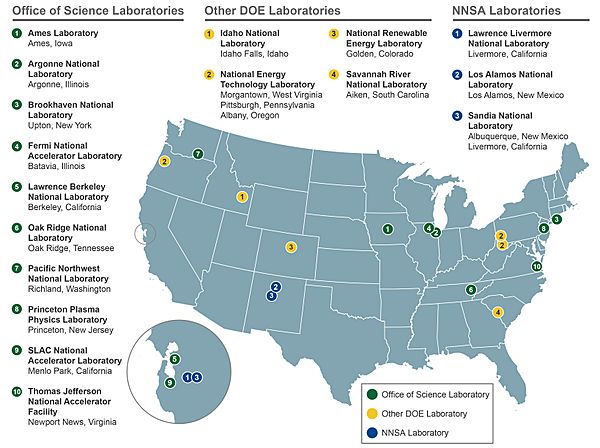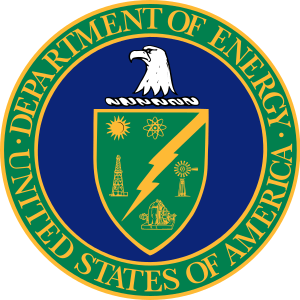United States Department of Energy national laboratories facts for kids
The United States Department of Energy National Laboratories and Technology Centers are special places where scientists and engineers do amazing research. These labs are managed by the United States Department of Energy (DOE). Most of these labs are run by private companies or universities, even though the government funds them. They work on many different science and technology projects.
How the Labs Started
These national labs grew out of big science projects during World War II. New technologies like radar, computers, and the atomic bomb were very important for the Allies to win the war. The U.S. government started investing in science for national security in World War I. But it was in the late 1930s and 1940s that huge amounts of money and effort went into wartime science. This was led by groups like the National Defense Research Committee.
During World War II, places like the Radiation Laboratory at MIT and Ernest O. Lawrence's lab at Berkeley became very important. Scientists worked together on big goals, with almost unlimited government money.
The secret project to build the atomic bomb, called the Manhattan Project, created several hidden sites. These included a lab in New Mexico led by Robert Oppenheimer (Los Alamos). There were also sites at Hanford, Washington and Oak Ridge, Tennessee. Private companies or universities managed these sites. Other universities also helped with important research, like the University of Chicago's work on reactors. This led to the creation of Argonne National Laboratory near Chicago.
After the war, the new Atomic Energy Commission took over these labs. They decided to keep them open permanently, even though they were first thought to be temporary. More money and resources were given to create other "national laboratories." These labs focused on both secret and basic research, especially in physics. Each lab often had very expensive machines, like particle accelerators or nuclear reactors.
Most national labs have their own scientists. They also let visiting scientists use their special equipment. Because they bring together so many resources and smart people, these labs are great examples of "Big Science". This means large-scale scientific research that needs a lot of money, people, and equipment.
The labs were encouraged to both compete and cooperate. Sometimes, two labs with similar goals were created, like Lawrence Livermore to compete with Los Alamos. The idea was that competition would lead to better work. Labs with different goals would work together. For example, Lawrence Livermore would cooperate with Lawrence Berkeley Laboratory.
The national lab system is now managed by the Department of Energy. It is one of the biggest science research systems in the world. The DOE provides about one-third of all the money for physics, chemistry, materials science, and other physical sciences research in the U.S. Many labs are run by private companies or universities. Together, they form an important link between the military, universities, and private businesses.
These National Labs can also work directly with private companies. They do this through special agreements called Laboratory Directed Research & Development (LDRD).
List of National Laboratories
The United States Department of Energy currently runs seventeen national laboratories. They are grouped under six different parts of the department:
| Name | Location | Established | Operated by |
|---|---|---|---|
| Office of Science | |||
| Lawrence Berkeley National Laboratory | Berkeley, California | 1931 | University of California (since 1931) |
| Oak Ridge National Laboratory | Oak Ridge, Tennessee | 1943 |
University of Chicago and DuPont (prior to ca. 1945) |
| Argonne National Laboratory | DuPage County, Illinois | 1946 | UChicago Argonne, LLC |
| Ames Laboratory | Ames, Iowa | 1947 | Iowa State University (since 1947) |
| Brookhaven National Laboratory | Upton, New York | 1947 |
Associated Universities, Inc. (1947–1998) |
| Princeton Plasma Physics Laboratory | Princeton, New Jersey | 1951 | Princeton University (since 1951) |
| SLAC National Accelerator Laboratory | Menlo Park, California | 1962 | Stanford University (since 1962) |
| Pacific Northwest National Laboratory | Richland, Washington | 1965 | Battelle Memorial Institute (since 1965) |
| Fermi National Accelerator Laboratory | Batavia, Illinois | 1967 | Fermi Research Alliance (since 2007) |
| Thomas Jefferson National Accelerator Facility | Newport News, Virginia | 1984 | Jefferson Science Associates, LLC (since 2006) |
| National Nuclear Security Administration | |||
| Los Alamos National Laboratory | Los Alamos, New Mexico | 1943 |
University of California (1943–2007) |
| Sandia National Laboratories | Albuquerque, New Mexico | 1948 | University of California (1948–1949) AT&T Corporation (1949–1993) |
| Livermore, California | |||
| Lawrence Livermore National Laboratory | Livermore, California | 1952 |
University of California (1952–2007) |
| Office of Energy Efficiency and Renewable Energy | |||
| National Renewable Energy Laboratory | Golden, Colorado | 1977 | MRIGlobal (1997–2008) Alliance for Sustainable Energy, LLC (since 2008) |
| Office of Environmental Management | |||
| Savannah River National Laboratory | Aiken, South Carolina | 1952 | Savannah River Nuclear Solutions, LLC (since 2008) |
| Office of Fossil Energy & Carbon Management | |||
| National Energy Technology Laboratory | Pittsburgh, Pennsylvania | 1910 | Department of Energy |
| Morgantown, West Virginia | 1946 | ||
| Albany, Oregon | 2005 | ||
| Office of Nuclear Energy | |||
| Idaho National Laboratory | Idaho Falls, Idaho | 1949 | Bechtel (prior to 2005) Battelle Memorial Institute (since 2005) |
Technology Centers
Some other important centers are:
- Bettis Atomic Power Laboratory* at West Mifflin (Pittsburgh), Pennsylvania (1949)
- Knolls Atomic Power Laboratory* at Niskayuna, New York (1946)
- Knolls also runs the Kenneth A. Kesselring site at West Milton, New York.
- New Brunswick Laboratory**, at Argonne National Laboratory
- Oak Ridge Institute for Science and Education* at Oak Ridge, Tennessee
- Radiological and Environmental Sciences Laboratory** Savannah River Ecology Laboratory
* GOCO (Government-owned, Contractor-operated) means the government owns it, but a private company runs it. ** GOGO (Government-owned, Government-operated) means the government owns and runs it.
In Popular Culture
- In the Netflix show Stranger Things, there's a made-up lab called Hawkins National Laboratory. It's run by the DOE in the fictional town of Hawkins, Indiana. In the show, this lab is later closed. This happens after it's found that a portal to another dimension, called the "Upside Down," was opened there. Also, unfair experiments were done on children to try and turn them into weapons.
- In the AMC show Breaking Bad, Walter White worked for Sandia National Laboratories before the first season of the show.



